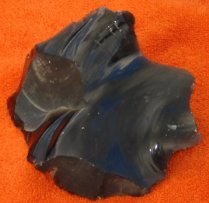Obsidian is a kind of volcanic glass, ranging from clear, through green, to (most typically) black in color. Obsidian is brittle, and cannot be carved, but when chipped the broken edge can be sharper than surgical steel, although easily broken. Both because of its wonderful properties as a blade and its unusual shiny black color, it was much valued through the end of the stone age.
Obsidian sources are limited, and it became a trade item of great value. For the same reason, it has been possible to identify chemical signatures for the slightly different trace elements found in different obsidian sources, so that some obsidian trading networks can be at least partially tracked.

Important and chemically distinctive deposits of obsidian are found in the Mediterranean area, especially Turkey, as well as in Mexico and in the Pacific.
When exposed to sudden extremely high temperatures, obsidian can be chemically transformed. The infamous Mesa Verde fire of 2000 produced some lumps of obsidian that had a very light per-volume weight, a gray color, and a puffy, brittle, Styrofoam-like consistency as a result of the extremely intense heat. (A naturally occurring variant of this is perlite, a volcanic product, like obsidian, but containing more water and exploded by volcanic heat. This is the light, water-absorbent, pop-corn-like stone sometimes used in potted plants.)
Dating. When obsidian is chipped, the newly exposed face gradually begins to absorb minute amounts of moisture. The portion of the artifact containing such moisture is referred to as the "hydration layer," and its thickness when the artifact is broken and seen in cross section (and much magnified) can be compared with hydration layers of other artifacts to produce an approximate relative date, a process referred as "obsidian hydration dating."
In actual practice, this is not simple, however, since the rate of hydration is a function of the conditions to which the artifact has been exposed over the course of his history, which it is not always easy to guess.
The upper picture shows a broken piece of unworked obsidian. The lower picture shows an eight-inch blade made of worked obsidian, with a long, even cutting edge.

Click here for More About flint.
Photos by DKJ
